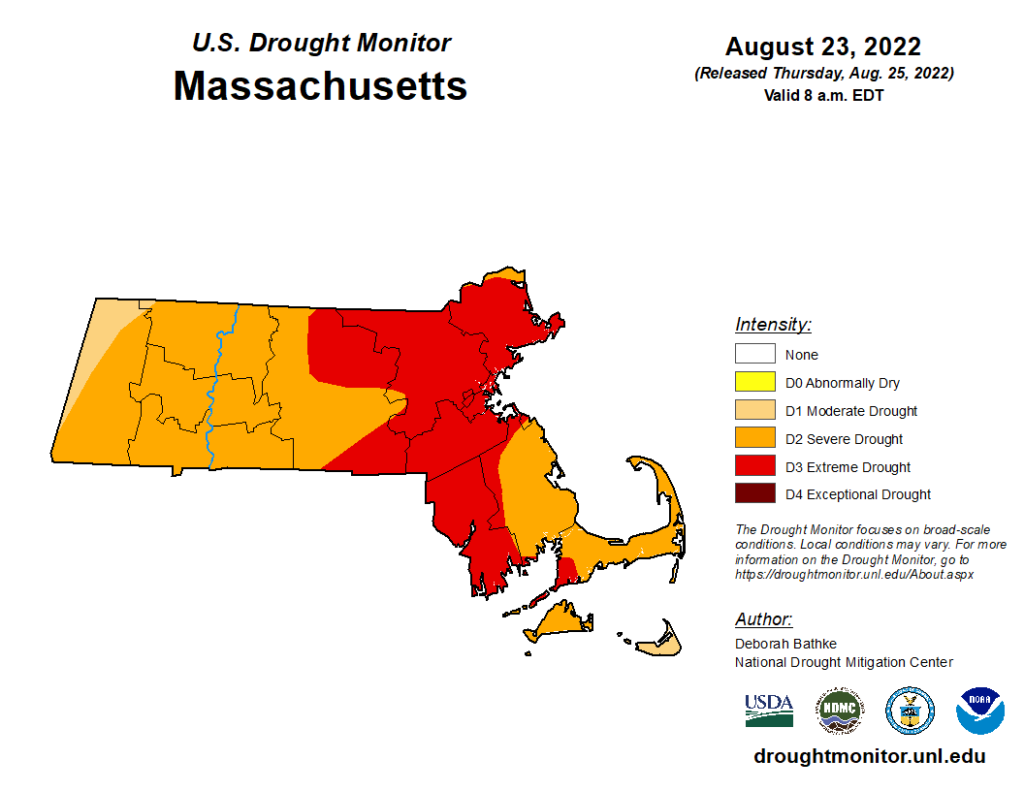
Drought Impacts 2022
Learn about the latest condition affecting the Cape.
The Cape Cod Cooperative Extension weather station in Barnstable recorded a mere 0.35 inches of precipitation for the entire month of July. And thus far in August (August 25) a total of 0.67 inches of precipitation was recorded. The US Drought Monitor for August 24 designates most of the Cape in a severe drought and some portions in extreme drought. The conditions have led to many local water utilities putting mandatory water restrictions into place and United States Department of Agriculture to declare Barnstable and 8 other Massachusetts counties as Primary Natural Disaster Areas due to the drought. The designation is important for farmers and ranchers to receive assistance as a result of disaster related losses.
The lack of precipitation in July and continuation into August quickly escalated drought conditions which were first designated moderate drought on July 19, severe drought on August 2 and portions of the county in extreme drought on August 9. During periods of drought, plants are stressed and damaged by low soil moisture levels. As low soil moisture conditions persist the stress and damage to plants increases. Some responses of plants to low soil moisture and water deficits include wilting, leaf scorch, premature defoliation and death. Currently, many of these conditions are visible in home landscapes as well as natural areas. While water stress is most often visible in lawns, container plants, vegetable gardens and flower gardens; woody plants also suffer. Woody plants can suffer both short term effects such as wilting, scorch and premature defoliation but also long-term effects. Long terms effects typically include increased susceptibility to disease and insect attack as well as slow declines and dieback. So, don’t forget to water your trees.
Supplemental watering is essential to keep plants healthy during periods of drought at the same time the importance of water conservation efforts also becomes vital. Therefore, extra emphasis should be placed on proper watering. When watering established plants in the landscape watering should be deep and infrequent. Deep meaning that irrigation should penetrate into the rootzone of the plants, 6-8” or more. To determine whether watering is deep enough, physically check by digging a hole and observing moisture infiltration. Infrequent meaning allowing soil to dry between watering events. Avoid the short frequent watering that is often used to irrigate lawns and/or hand watering that is done with a hose and nozzle – these types of watering are rarely sufficient and end up being both wasteful and counterproductive.
Severe and extreme drought conditions have recently occurred in 2016 and 2020. These types of droughts are also predicted as a result of climate change to be more frequent. Which means we should be thinking beyond watering our plants during drought to building and maintaining landscapes more resilient to drought. Drought resilient landscapes include incorporating more drought tolerant plants, building better soils, and incorporating water saving technologies. Check out these many resources to begin making better use of the water you are using and reducing your future water use.
General
- https://ag.umass.edu/landscape/fact-sheets/long-term-drought-effects-on-trees-shrubs
- https://ag.umass.edu/home-lawn-garden/fact-sheets/water-conservation-in-home-garden-landscape
- https://ag.umass.edu/landscape/fact-sheets/efficient-outdoor-watering
- https://ag.umass.edu/landscape/fact-sheets/indoor-outdoor-residential-water-conservation-checklist
- https://ag.umass.edu/fact-sheets/managing-soil-structure-for-water-conservation-in-landscape
- https://ag.umass.edu/fact-sheets/measuring-soil-moisture
- https://ag.umass.edu/landscape/fact-sheets/role-of-irrigation-audit-in-water-conservation
- https://ag.umass.edu/landscape/fact-sheets/trickle-irrigation
- https://ag.umass.edu/landscape/fact-sheets/landscaping-to-conserve-water
New plantings
Lawn Specific
- https://ag.umass.edu/home-lawn-garden/fact-sheets/turf-irrigation-water-conservation
- https://ag.umass.edu/home-lawn-garden/fact-sheets/management-tips-to-improve-turfgrass-drought-survival
- https://ag.umass.edu/home-lawn-garden/fact-sheets/maximizing-irrigation-efficiency-water-conservation
Drought tolerant plants
- https://ag.umass.edu/home-lawn-garden/fact-sheets/drought-tolerant-annuals-perennials
- https://ag.umass.edu/landscape/fact-sheets/drought-tolerant-perennials
- https://ag.umass.edu/landscape/fact-sheets/drought-tolerant-plants-for-landscape
- https://ag.umass.edu/landscape/fact-sheets/ornamental-grasses-for-water-conservation-in-landscape




